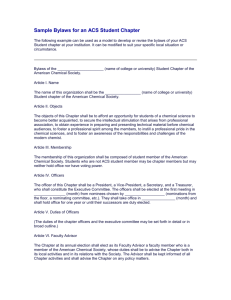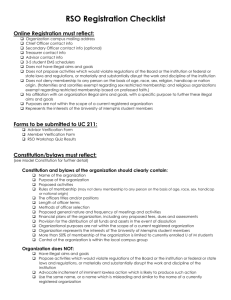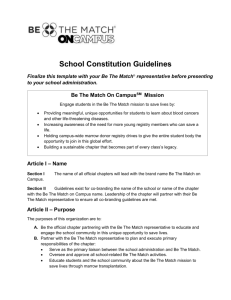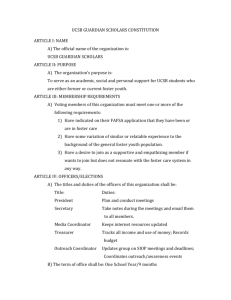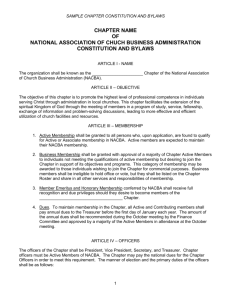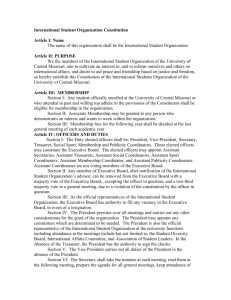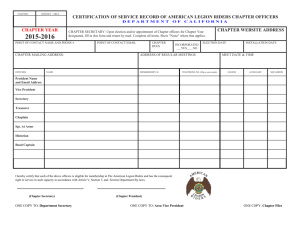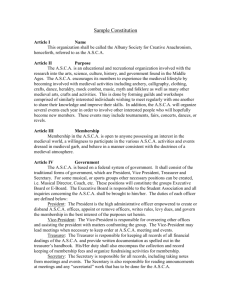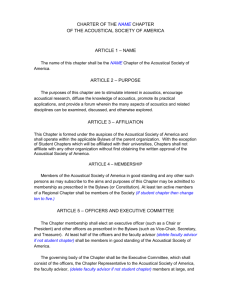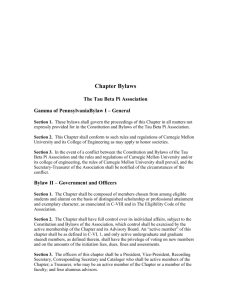Sample Constitution - Leadership and Campus Life
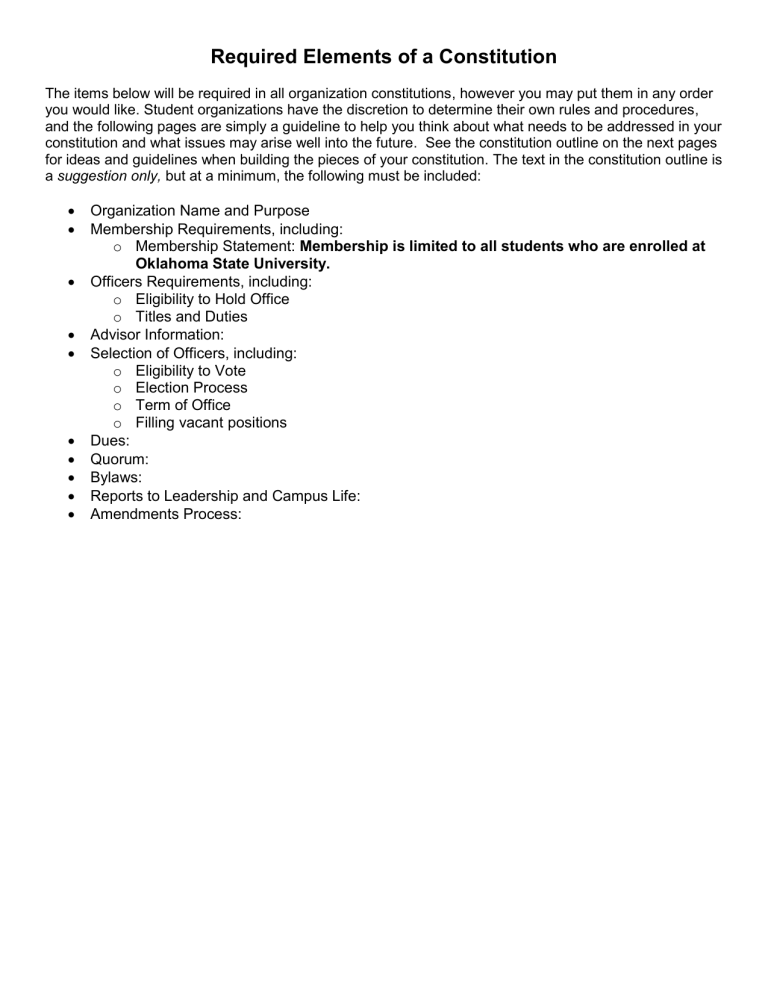
Required Elements of a Constitution
The items below will be required in all organization constitutions, however you may put them in any order you would like. Student organizations have the discretion to determine their own rules and procedures, and the following pages are simply a guideline to help you think about what needs to be addressed in your constitution and what issues may arise well into the future. See the constitution outline on the next pages for ideas and guidelines when building the pieces of your constitution. The text in the constitution outline is a suggestion only, but at a minimum, the following must be included:
Organization Name and Purpose
Membership Requirements, including: o Membership Statement: Membership is limited to all students who are enrolled at
Oklahoma State University.
Officers Requirements, including: o Eligibility to Hold Office o Titles and Duties
Advisor Information:
Selection of Officers, including: o Eligibility to Vote o Election Process o Term of Office o Filling vacant positions
Dues:
Quorum:
Bylaws:
Reports to Leadership and Campus Life:
Amendments Process:
Constitution Outline
Items in bold are required, Items in italics are suggestions and guidelines from Leadership and Campus
Life.
Article I - Organization Name
This section should be used to state your organization name and any acronyms or nicknames that your organization will use.
Example: The name of this organization shall be Yankee Doodle Derek (YDD).
Article II - Purpose
This section should be utilized to outline the mission and/or vision of your organization . What is the purpose of the organization? What type of student interest do you attract?
Example: The purpose of this organization shall be …
Article III - Membership
Voting membership is limited to currently enrolled OSU students. o This is a requirement set forth in the OSU Rights and Responsibilities Governing Student
Behavior, which can be found here: link to rights and responsibilities (page 12). o Some organizations have different levels of members, or have privileges given to active membership or members that must remain in “good standing”. You should consider explaining what “active membership” or “good standing” entails for your organization so that it is clearly defined if you are using such terms. If you have other categories (faculty/staff or community members) you may establish “Honorary” or “Associate” memberships, but these categories would not have voting privileges.
Article IV - Officers:
Section 1: Eligibility o This section should outline what requirements your organization has set for members of your organization to hold officer positions. (GPA, held a previous position, completed certain requirements, etc.) OSU requires all officers to be enrolled full-time (12 hours undergrad, 6 hours grad) and have a minimum of a 2.0 gpa for undergraduates and a 3.0 for graduate students.
Section 2: Titles and Duties o List a separate section for each officer. These sections should include the titles of each officer and outline the responsibilities of each officer. OSU requires you to have a
President, Vice President, Secretary and Treasurer. In this section you must include the following text in the duties for Treasurer – The Treasurer will attend the annual
Treasurer’s Workshop or complete the Treasurer’s Training Module online.
o Example:
The President shall:
The Vice President shall: o If you have additional officers that are permanent and will always be filled, you can include them here. Otherwise, it is suggested that you include a statement similar to this at the end of this section:
Other officers/committee chairs may be established as outlined in the bylaws of this organization. o You should include the Advisor in this section as well – the University requires that you have a full time faculty or staff member as an advisor. The following wording should be part of this section: The Advisor will be a full time faculty or staff member of OSU (you can then add any other requirements your group has for the advisor, such as teaching in a particular department, holding membership in a particular professional association or having an interest in the purpose of the organization) This section should also discuss how the Advisor will be selected and their general duties.
The advisor should not have any voting rights within the organization.
Information on Advisors can be found at link to rights and responsibilities (page 4).
Article IV - Elections:
Section 1: Eligibility to Vote o This section should discuss who within the organization has the ability to vote. Is voting open to anyone in attendance in the meeting? May only members in “good standing” vote?
Section 2: Nomination Process o This section is optional and should outline your nomination process. It can also be combined with the election process in the following section.
o Example: The nomination of officers shall occur at the first meeting held in November.
Any eligible member present may nominate someone or themselves for office, provided the nominee is eligible to hold office.
Section 3: Election Process o This section should outline your election process. We highly encourage that organizations function very democratically. The nomination and election process should be fair to all members of the organization and allow an opportunity for the membership of the organization to have a voice in the election of the officers. This section should also include when the election will be held (end of spring semester, etc.) o Example: The election of officers shall occur at the second meeting held in November.
The nominated candidates will be given a chance to address the organization. Once each candidate has had the opportunity to speak, all eligible members present will have the opportunity to vote as outlined in the bylaws.
Section 4: Term of Office o In this section, describe how long officers will serve in their positions. Will the term be one calendar year? Can officers be re-elected for a second term?
Section 5: Filling Vacant Officer Positions o This section should describe how your organization will fill a vacant officer position. Some organizations will have a nomination/election process for the open position as outlined
above in the process of nominations and elections, however some have an election immediately or appoint someone to fill the position until an election.
Article V - Quorum
Quorum is the number of members required to be present in order for the organization to conduct official business. Generally, this is considered to be simple majority (50% of members plus one). Your organization may select a different percentage, either higher or lower, but you will be asked to give rationale for this decision. For most groups, this section should read as follows: Quorum for this organization shall be a simple majority (50% of voting members, plus one).
Article VI –Bylaws
This section should deal with the process for changing by-laws, but should not have the actual bylaws listed here. The constitution is a broader explanation of organizational workings while the bylaws are specifics. Example: A by-law may be passed at any regular meeting of the organization by a majority vote of those in attendance, providing a quorum is present.
Article VII – Dues
This section should outline whether or not your organization will have dues. Most organizations include the following statement, unless there are mandatory dues that must be collected for
membership in a national/professional association. Example: Dues for this organization, if any, shall be collected as outlined in the bylaws.
Article VIII
Reports to Leadership & Campus Life Office:
Section 1.
At the beginning of the fall semester, (name of organization ) shall report the name of officers and advisors to the Department of Leadership and Campus Life and shall promptly report any changes that occur during the school year. (Changes in the officers and/or faculty advisors occurring during the year MUST be reported to the Department of Leadership and Campus Life promptly to keep organizational records current. Updates should be made through the CampusLink program at www.campuslink.okstate.edu
.)
Section 2.
At the beginning of the fall semester, (name of organization) will file with the Department of Leadership and Campus Life a signed “Affirmation of Compliance.”
(Forms may be signed electronically at here .)
Section 3.
The funds of (name of organization) , if any, will be deposited with the University banking services and these may be audited yearly, preferably at the time a new treasurer is installed.
Section 4.
It is understood that failure to submit such materials, either through continued negligence or willful omission, may result in the suspension of the charter of this organization by the
Committee on Student Organizations.
Article IX: Amendments
This section should discuss how amendments to the constitution can be made. Who must the amendments be proposed to? Will they be made at meetings? What percentage of your organization must be in attendance in order to pass an amendment? Just like elections, all members should have the opportunity to vote on changes to the constitution, since it does pertain to all members. OSU requires the following wording at the end of this section: All changes to the constitution will be submitted to the
Department of Leadership and Campus Life for approval by the Committee on Student
Organizations.
